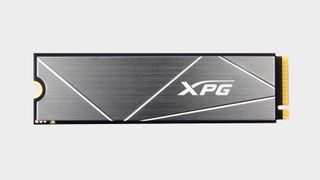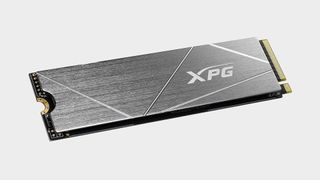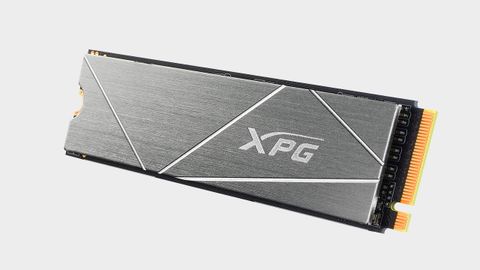Our Verdict
Thanks to a cut-down four-channel controller, the XPG Gammix S50 Lite combines PCIe Gen 4 with proper TLC flash memory to deliver reasonable performance at a tempting price.
For
- 96-layer Micron TLC memory
- Five-year warranty
- Low operating temps
Against
- Only four memory channels
- Slightly suspect sustained performance
PC Gamer's got your back
The PCI Express Gen 4 interface is rapidly approaching default status, especially if you’re talking new as opposed to installed hardware. Intel’s latest desktop and mobile CPUs support it, AMD having jumped on the PCIe 4.0 wagon back in 2019. The Xbox Series X/S and Playstation 5 also support the standard.
As for solid-state drives, we’re now well through the early adopter stage, with numerous high-end PCIe 4.0 drives available, plus several value drives. The new ADATA XPG Gammix S50 Lite, sampled here in 2TB configuration and M.2 2280 format, falls into the latter category. But where some Gen 4 drives achieve a lower price point by using cheap and not always terribly cheerful QLC or quad-level flash memory, ADATA has managed to price TLC or triple-level flash memory into the bargain, in this case, 96-layer Micron chips.
Capacity: 2TB
Interface: PCIe 4.0 x4
Controller: Silicop Motion SM2267
NAND: Micron 96-layer TLC
DRAM cache: 1GB
Rated seq. read: 3,900 MB/s
Rated seq. write: 3,200 MB/s
Rated IOPS read: 490K
Rated IOPS write: 540K
Endurance: 1,480TB
Warranty: 5 years
Price: $270 (£256)
Without wishing to instruct anyone in the fine art of orally applying a vacuum to an oocyte, as you add cell levels and therefore data density to NAND flash memory, you lose performance and endurance. QLC is slower and doesn’t last as long as TLC before wearing out. Much of that can be masked with tricks like running a portion of the drive in pseudo-SLC mode for improved performance, as is indeed the case with the Gammix S50 Lite. But you’ll catch up with the underlying performance of whatever flash memory you’re using eventually. More on which in a moment.
Anyway, how has ADATA pulled off TLC at this kind of price point? The answer, at least in part, is a more affordable PCIe Gen 4 controller chip. The original Gammix S50 was a high-end PCIe Gen 4 drive with the Phison controller. This ‘Lite’ model is cheaper and powered by the new Silicon Motion SM2267 controller.
It’s the low-cost option from SM’s latest range of PCIe 4.0 controllers. For starters, it’s fabbed on a cheaper 28nm production node, where fancier controllers are typically manufactured on 12nm or thereabouts. It’s also limited to four memory channels and two ARM Cortex R5 CPU cores. The SM2267’s SM sibling, for instance, is on 12nm, has eight memory channels and rocks four Cortex R8 cores.

That said, this new budget PCIe 4.0 controller is faster than SM’s previous-gen high-end PCIe 3.0 controller, the SM2263, with 1,200MT/s peak performance to the older chip’s 800MT/s. What’s more, the increasing density of flash chips means you can achieve large capacities with just four channels, in this case fully 2TB. One other area of arguable corner-cutting is RAM allocation. The ADATA XPG Gammix S50 Lite gets 1GB of DDR4 cache where you might expect 2GB for a drive with 2TB of capacity. Still, a bit less DRAM is much better than no DRAM at all.
For the record, the official performance claims include sequential throughput of 3,900MB/s for reads and 3,200MB/s and for writes, while the 4K random access is pegged at 490K read IOPS and 540K write IOPS. Overall, then, the philosophy here is actually pretty straightforward. ADATA is aiming to achieve something akin to premium eight-channel PCIe Gen 3 performance, drives like the previous-gen WD Black SN750 or the Kioxia Exceria Plus, with a lower cost quad-channel PCIe Gen 4 drive.
Rounding out the speeds, feeds and specs is 1,480TB of write endurance, which should be plenty for all but a tiny fringe of ultra-intense users and a healthy five-year warranty. Physically, this 80mm M.2 drive gets a thin, flat heat spreader which is claimed to reduce temps by up to 20%. All told, you’re looking at a cost of around three quarters that of a high-end PCIe Gen 4 drive with a more expensive eight-channel controller. So, it’s a pretty attractive proposition on paper.








But what about, you know, the performance? Peak performance in the most forgiving benchmark, namely CrystalDiskMark 7, is in line with the claims, notching up 3.9GB/s reads and 3.2GB/s writes. The ATTO and AS SSD metrics are a little lower, but either way, the numbers are very much competitive with a high-end PCIe 3.0 drive.
We've compared this drive to the Samsung 980 1TB ($110), Silicon Power US70 2TB ($350), and the fastest SSD around, the WD_Black SN850 1TB ($200). This covers other budget offerings as well as pure speed alternatives.
As for 4K random access, again it depends somewhat on the application used. But the broad-brush conclusion is that the ADATA XPG Gammix S50 Lite 2TB returns if anything numbers slightly above expectation if not at all remarkable, at 71MB/s for reads and in the low to mid 200s for writes.
Temperatures are very well managed, with a peak of just 53°C in testing. The well-managed temps imply that the drop from 1.1GB/s initial internal file copy speed to a fluctuating range between 300MB/s to 500MB/s after around 350GB of data is related to exhausting the SLC cache rather than thermal throttling. However, 3,300MB/s to 500MB/s is rather lower than we would normally expect for TLC flash, so that aspect is inconclusive.

Overall, the ADATA Gammix S50 Lite 2TB delivers pretty much on the initial proposition. It largely does perform in line with a high-end PCIe 3.0 drive. The low peak operating temps are impressive too, if arguably academic given the one obvious weak area, namely sustained performance. Still, if you’re looking for a 2TB SSD with a proper five-year warranty and no performance nasties, this is worth popping on your shortlist, provided you can find it cheap enough for the proposition to hang together. Otherwise, check out our guide to the best SSDs for gaming.
Thanks to a cut-down four-channel controller, the XPG Gammix S50 Lite combines PCIe Gen 4 with proper TLC flash memory to deliver reasonable performance at a tempting price.

Jeremy has been writing about technology and PCs since the 90nm Netburst era (Google it!) and enjoys nothing more than a serious dissertation on the finer points of monitor input lag and overshoot followed by a forensic examination of advanced lithography. Or maybe he just likes machines that go “ping!” He also has a thing for tennis and cars.

Riot has been slowly chipping away at build creativity in League of Legends, all in the name of balance, but there are better solutions

Deus Ex director Warren Spector thinks that 'if someone made Deus Ex today it might be perceived as a documentary,' so if he made a new one it would be pretty different

Today's Wordle answer for Sunday, November 10
